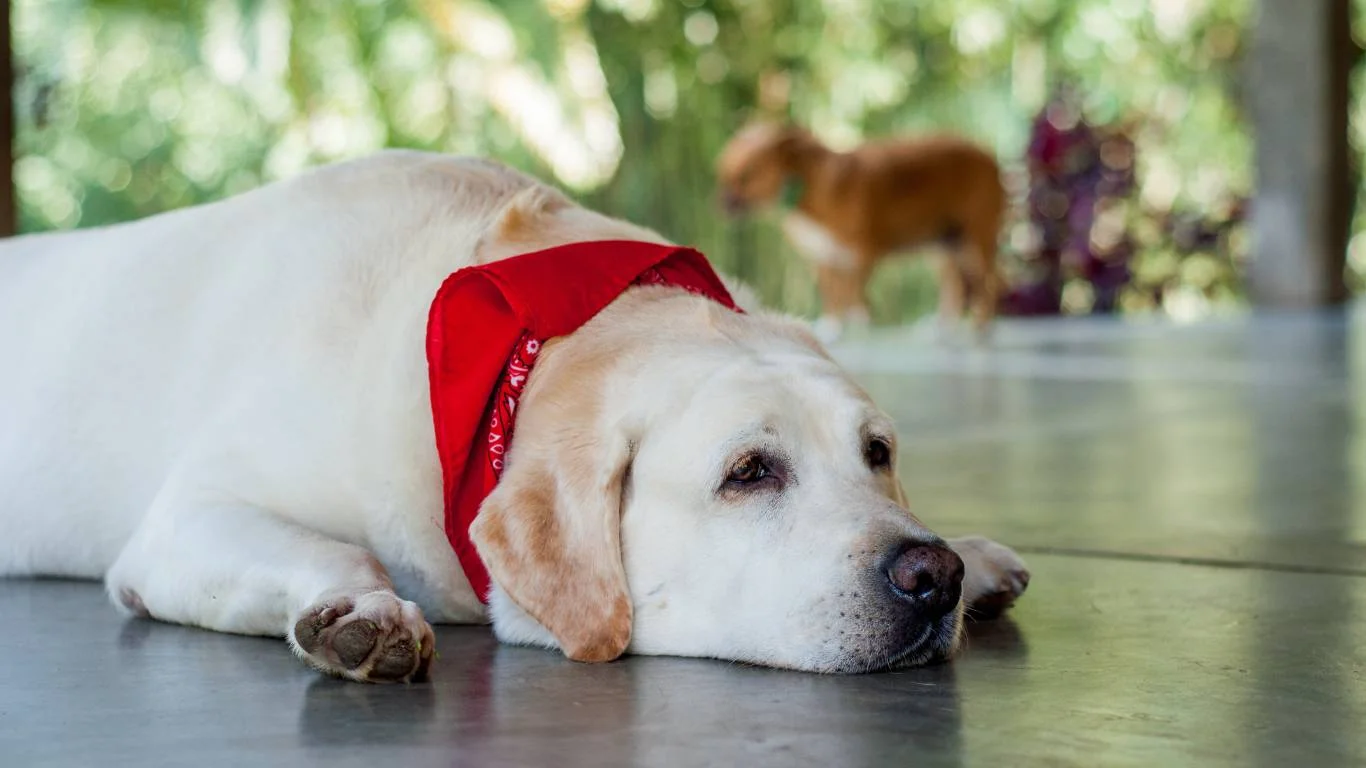Best Ways to Help a Dog with Hip Dysplasia Pain Naturally
If you’ve ever watched your furry best friend struggle to stand up, limp after playtime, or hesitate before hopping onto the couch, you know how heartbreaking it is. I’ve been there with more than one pup—and it never gets easier. As a veterinary assistant with a strong focus on nutrition, I’ve had the chance to work closely with dogs dealing with joint problems, especially hip dysplasia. That’s why I wanted to share what I’ve learned firsthand on how to help a dog with hip dysplasia pain. There are a lot of things you can do—from small everyday changes to more structured support—that can make a massive difference in your dog’s comfort and quality of life.
What Exactly Is Hip Dysplasia in Dogs?

Let’s break it down simply. Hip dysplasia happens when the ball and socket of a dog’s hip joint don’t fit together quite right. Instead of smooth, fluid movement, the joint grinds, causing inflammation, pain, and eventually arthritis. It’s especially common in larger breeds like Labs, German Shepherds, and Golden Retrievers, but I’ve seen it in plenty of mixed breeds and even smaller dogs, too.
It can start young, but often the real discomfort shows up as they age. One of the sweetest dogs I worked with—a chocolate Lab named Moose—was only four when he began limping. His folks thought he had just overdone it at the dog park, but X-rays told a different story. Thankfully, there are many ways to manage the condition and ease your pup’s discomfort.
Signs Your Dog Might Be in Pain

Before jumping into treatments, it helps to know what you’re dealing with. Dogs can’t tell us directly when something hurts, but their behavior definitely can.
Common symptoms of hip dysplasia pain:
- Reluctance to jump, run, or climb stairs
- Limping or favoring one leg
- Back legs that look wobbly or weak
- Stiffness after sleeping or resting
- Muscle loss in the hindquarters
- Whining, especially when touched near the hips
Honestly, it’s easy to miss early signs. Moose didn’t cry or act dramatically—he just moved a little slower than usual. If you’re noticing any of these symptoms, it’s a good idea to talk to your vet and get a proper diagnosis. That way, you can rule out other issues and start a tailored care plan.
How to Help a Dog With Hip Dysplasia Pain

Here comes the good news—there are so many ways you can make life easier for your pup. Some involve lifestyle tweaks, others might include supplements or treatments recommended by your vet. It’s not just about meds either—though they can help. Managing hip dysplasia pain is often a combination of things.
Start With a Comfortable Living Space
First things first—make your dog’s daily environment hip-friendly. A few small changes around your home can go a long way:
- Provide orthopedic bedding: Memory foam dog beds that support joints can reduce pressure on painful hips.
- Use ramps or stairs: Help your dog access their favorite spots without jumping. I had a dachshund patient whose owner built her a little staircase up to the couch—game changer!
- Place rugs on slippery floors: Hardwood or tile can be hard for arthritic pups to navigate. Rugs give them grip and confidence.
Keep Them Moving, Gently
It might sound strange, but resting too much can make things worse. I always tell clients: motion is lotion for the joints. Of course, you don’t want high-impact play, but low-key activities like these can help keep the joints lubricated and muscles strong:
- Short, slow walks—daily, not just on weekends
- Swimming (if your dog enjoys it)—low impact and great for joints
- Stretching exercises—ask your vet for canine-specific movements
Every dog is different. One golden retriever I worked with loved water therapy, while another just preferred sunbathing on the porch. Find what works for your pup and build it into your routine.
Nutrition Is a Game-Changer
This is where my focus on canine nutrition comes in. What your dog eats absolutely affects their joint health. Certain nutrients can reduce inflammation, support cartilage, and promote better mobility.
Some basics to look for:
- Omega-3 fatty acids: Especially from fish oil, these can reduce joint inflammation. I often recommend anchovy- or sardine-based oils since they’re lower in toxins than some others.
- Glucosamine and chondroitin: These help protect and repair cartilage. Many high-quality joint supplements include both.
- Turmeric or curcumin: Natural anti-inflammatory with fewer side effects than medications, but still powerful. Just check dosing with your vet.
I’ve worked with several pet parents who switched to joint-supportive diets and noticed their pups getting peppier in just a few weeks. It’s not a miracle, but it’s a solid piece of the puzzle.
Supplements That Can Truly Make a Difference

Alright, let’s talk supplements. I’ve had pet parents ask me countless times—“Do joint supplements actually work?” And here’s the truth from someone who’s seen it play out both ways: yes, but you have to be consistent and pick the right ones.
I remember this spunky old boxer named Daisy. Her owners started her on a joint supplement with glucosamine, MSM, and green-lipped mussel. Within a month, Daisy was bouncing around like she had shaved a few years off her age. Now, not every pup shows dramatic improvement, but when supplements are high-quality and used regularly, they can definitely ease discomfort and boost mobility.
My go-to supplements for hip dysplasia pain:
- Glucosamine + Chondroitin: Help rebuild cartilage and slow joint degeneration.
- MSM (Methylsulfonylmethane): Reduces inflammation and improves joint flexibility.
- Green-lipped mussel: A natural source of omega-3s, antioxidants, and joint-building nutrients.
- CBD oil (vet-approved only): Anecdotally helpful for pain management and inflammation, though more research is needed.
One key piece of advice? Always go with a brand that’s vet-recommended or third-party tested. There are a lot of products out there with flashy labels that don’t deliver much.
Vet-Prescribed Pain Management

While I’m all about natural approaches and lifestyle support, there are definitely cases where dogs need medical pain relief. When I assisted in post-op care at our clinic, some dogs with advanced hip dysplasia were on prescribed NSAIDs or other medications just to stay comfortable enough to move.
Medications commonly used:
- Carprofen, Meloxicam, or Deracoxib: These are anti-inflammatory drugs designed for dogs. They reduce swelling and help relieve pain, but they should always be used under veterinary guidance since long-term use can affect liver or kidney function.
- Gabapentin: Often used for nerve-related pain or as an adjunct to NSAIDs.
- Adequan injections: This is an injectable medication that protects cartilage and supports joint repair. It’s one of my personal favorites—I’ve seen it work wonders for pups who didn’t respond to oral meds alone.
If your dog seems to be in serious discomfort, please don’t wait. Get them checked out. The right meds can make all the difference in the world.
Physical Therapy & Alternative Treatments

One of the coolest things I’ve seen over the last few years is how many pet parents are turning to physical therapy and holistic treatments. These aren’t just for humans anymore! Dogs with hip dysplasia can benefit massively from therapies that focus on strengthening muscles, improving flexibility, and reducing inflammation without heavy meds.
Therapies that support hip health:
- Hydrotherapy: Think underwater treadmills or swimming sessions. It’s low impact, builds strength, and most dogs LOVE it. I had a husky patient who hated baths but would dive into the rehab pool like an otter!
- Laser therapy: A gentle, non-invasive light treatment that reduces pain and boosts tissue healing. It’s one of the treatments we used regularly at our clinic for chronic joint conditions.
- Acupuncture: Yep, for dogs too! Some vets are certified in acupuncture and use it to stimulate blood flow and release natural pain-relieving chemicals.
- Massage and stretching: Gentle massage helps release tension around the hips. Ask your vet or a canine massage therapist for guidance so you’re applying the right pressure in safe areas.
All of these approaches are great complements to more traditional treatments. If you’re lucky enough to live near a canine rehab center—go check it out. Even a session or two can give you a whole new toolkit for supporting your pup at home.
Daily Routines That Support Healing
Beyond supplements and therapy, it’s the everyday stuff that really stacks up over time. I always tell folks: the more consistently you stick to supportive habits, the better your dog’s outcome will be.
What I recommend for your daily routine:
- Morning stretch and short walk: Get the joints moving early in the day.
- Midday rest on supportive bedding: Let them recharge somewhere soft and cozy, away from cold tile floors.
- Meal with joint-supporting nutrition: Add omega oils, mix in supplements, and avoid kibble loaded with fillers.
- Gentle evening movement: Another short walk, some light play, or massage time.
- Consistent schedule: Dogs love routine. Predictable activity and rest help reduce stress and stiffness.
It doesn’t have to be perfect. Some days will be better than others. What matters most is showing up for your pup in small ways that add up to big relief over time.
Keeping Your Dog’s Weight in Check

This is a biggie—and honestly, one of the most overlooked things when it comes to managing how to help a dog with hip dysplasia pain. Keeping your dog at a healthy weight isn’t just about looks—it’s about joint health. Excess weight puts added stress on those already painful hips, and I’ve seen dogs improve just by shedding a few pounds.
There was a beagle I worked with (we’ll call him Max), and Max loved his treats. His joints, however, did not. After working with his owner to introduce low-calorie training treats, better food portions, and more activity, Max lost about 15% of his body weight. The difference in his mobility? Night and day.
Tips for weight management:
- Measure every meal: “Eyeballing” it leads to overfeeding. Use a proper measuring cup or scale.
- Switch to a joint-supportive or weight-control formula: These are lower in calories but still rich in nutrients and protein.
- Replace treats with praise or low-cal veggies: Carrots, green beans, or even a slice of apple can work wonders. Just go easy on the portions.
Your vet or a certified pet nutritionist can help you build a food plan that keeps your dog’s weight in the safe zone without making them feel like they’re missing out.
Creating a Hip-Friendly Home Environment

Let’s be real: your dog spends the majority of their time at home. So, creating a space that supports their mobility is one of the kindest things you can do. I’ve seen huge improvements when owners make just a few thoughtful adjustments around the house.
Simple home upgrades that help:
- Orthopedic dog beds: A good bed supports joints and prevents stiffness. Memory foam beds are worth every penny.
- Non-slip rugs or runners: Especially in hallways or near food bowls, these can prevent painful slips and falls.
- Elevated food and water bowls: Reduces strain on hips and neck while eating or drinking.
- Ramps for vehicles or stairs: Jumping is a big no-no. Ramps make it safer and easier for your dog to get around.
One of my favorite setups was from a client with an elderly golden retriever. They had a whole little “chill zone” in their living room—complete with orthopedic bedding, a heated mat for the colder months, and a water bowl right within paw’s reach. That’s the kind of care that adds comfort and dignity to a dog’s daily life.
Knowing When It’s Time to Adjust the Plan
Managing hip dysplasia isn’t a “set it and forget it” thing. Dogs age, their needs shift, and what worked six months ago might not cut it now. The key is to stay in tune with your dog’s signals. Are they limping more? Slower to get up? Losing muscle mass?
Keep an open dialogue with your vet and don’t be afraid to tweak the plan. Sometimes that means upping a supplement dose, starting new therapies, or even considering surgical options in severe cases.
When to re-evaluate treatment:
- Sudden or worsening limping
- Reluctance to walk or climb stairs
- Loss of appetite or change in mood
- Noticeable weight gain or loss
- Changes in sleep patterns or increased restlessness
Trust your gut. You know your dog better than anyone, and those small changes matter.
Final Thoughts from a Vet Assistant’s Perspective
If there’s one thing I’ve learned working with dogs over the years, it’s this—dogs are incredibly resilient. Even with chronic conditions like hip dysplasia, they can still live happy, fulfilling lives when given the right care, attention, and love.
I’ve seen senior dogs bounce back with the help of thoughtful adjustments and caring owners. I’ve helped first-time pet parents figure out confusing supplement labels and coached them through weight-loss journeys. And the one thing that stays true? Your dog will always thrive most when they know you’re showing up for them every day.
Whether it’s choosing the right food, installing a ramp, or giving daily belly rubs after therapy—every small act adds up to big relief.
References
- American Veterinary Medical Association (AVMA)
- American College of Veterinary Surgeons (ACVS)
- American Kennel Club (AKC)
- PetMD
- Cornell University College of Veterinary Medicine
Disclaimer
This article is intended for informational purposes only and does not substitute for professional veterinary advice. Always consult your veterinarian before starting any new treatment, supplement, or therapy plan for your dog. Every dog is different, and what works for one may not be right for another.





